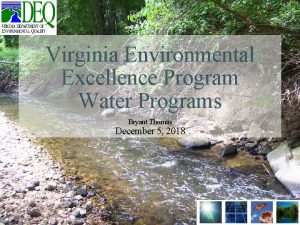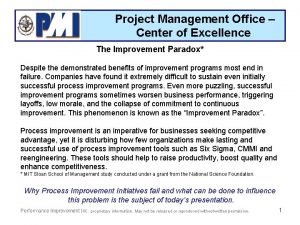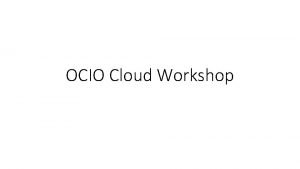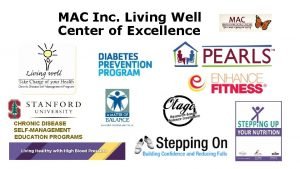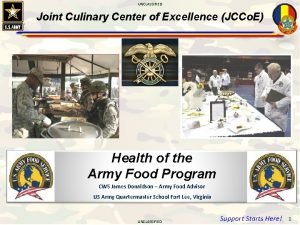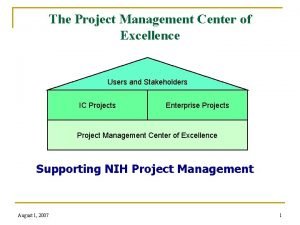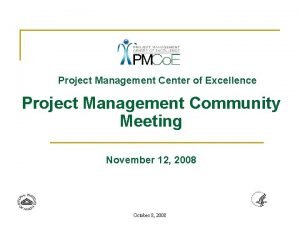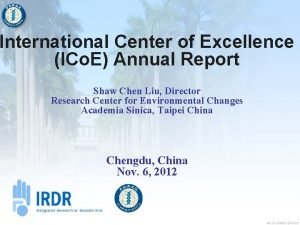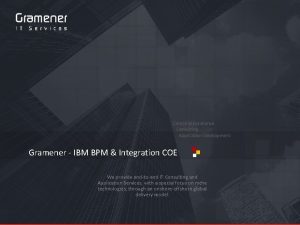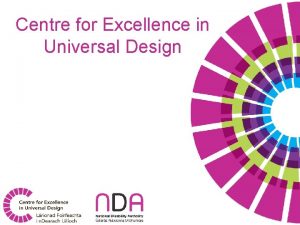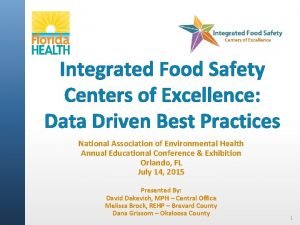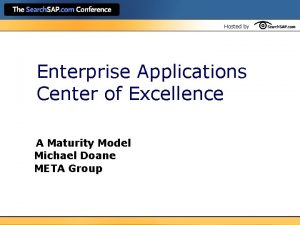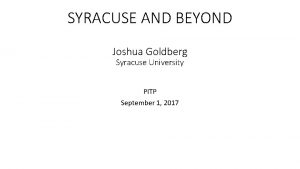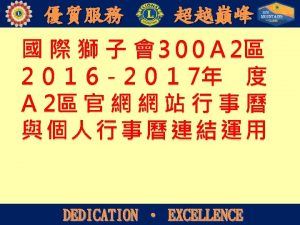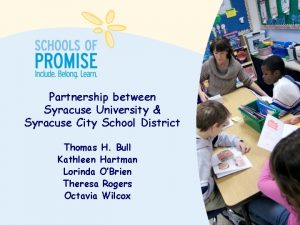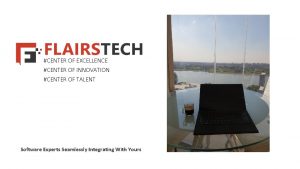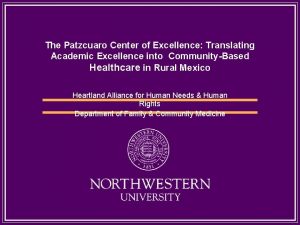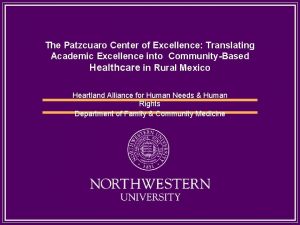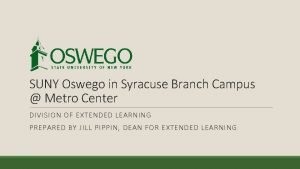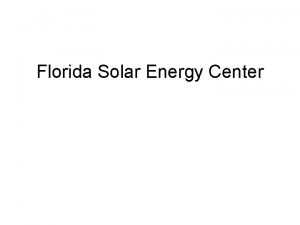SYRACUSE CENTER OF EXCELLENCE in ENVIRONMENTAL and ENERGY












- Slides: 12

SYRACUSE CENTER OF EXCELLENCE in ENVIRONMENTAL and ENERGY SYSTEMS U. S. Environmental Protection Agency Contract # CR 83199201 -0 Science Advisory Committee Review of “Task 4. 6” Activities By John J. Vasselli Executive Vice President Syracuse Center of Excellence Office for Industry Collaboration July 26 -7 , 2006

PRESENTATION OUTLINE - INTRODUCTION - TASK STRUCTURE, EMPHASIS & PROCESS - TASK 6 DESCRIPTION - TASK 4. 6. 1 - Technology Application and Demonstration Projects - TASK 4. 6. 2 – Entrepreneur/Internship Program - TASK 4. 6. 3 – Public Outreach Program ***** - TAD PROJECT REVIEW - TASK 4. 6. 1 A - Effects of Air Quality Factors on Human Decision Making - U. Satish - TASK 4. 6. 1 B – Performance Characterization of a New Ultra-fine Particle Counter - J. Vasselli - TASK 4. 6. 1 C – Real-Time Analysis of VOCs Based Upon A Field Portable GC/MS – J. Fair 2

INTRODUCTION • During the past year, the New York Indoor Environmental Quality (NYIEQ) Center officially changed its name, and has begun “doing business as” the: Syracuse Co. E Office for Industry Collaboration (OIC) • The OIC remains an independent, non-profit (501 c 3) corporation established by the State of New York, with the OIC name registered as the official “dba” of the NYIEQ. • A primary mission of the OIC remains the same - to improve industry-academia collaboration in the area of environmental systems, especially associated with indoor air quality as it affects human health and performance. • The OIC also serves as a technology transfer “bridge” between the 12 Academic Research Institutions that comprise the Syracuse Center of Excellence and over 5, 500 employees working in approximately 100 IEQ/IAQ-related companies throughout Central NY. • Together, these companies and research institutions represent one of the largest environmental industry clusters in the Nation. * 3 * Battelle “Essential New York” Study Findings, March 2004.

EPA Contract – Task Structure Task 4. 6: Technology Transfer and Demonstration This task directly supports the overarching Co. E Mission to: “Create innovations that improve human health and productivity, security, and sustainability in built and urban environments. ” Technology Application and Demonstration Projects (Subtask 4. 6. 1) – This subtask serves as the primary vehicle for accelerating the development, demonstration and evaluation of new technology-driven indoor environmental/air quality products developed within the large Upstate New York “environmental cluster” resident in New York State. Entrepreneur/Internship Programs (Subtask 4. 6. 2) - The most effective way to achieve “technology transfer, ” is through “people transfer”. This subtask fuels an important mechanism for achieving this objective, through the creation of a student internship grant project that introduces students to local companies and environmental career opportunities. Public Outreach Program (Subtask 4. 6. 3) - This outreach program provides valuable pathways through which companies and the general public can be made aware of new technical results and /or methods derived from research activities within academia, industry and government. 4

Task 6. 1 Technology Application & Demonstration Project Identification & Selection Process Approx. 100 Industry Interactions/yr INDUSTRY INTEREST 20 Technology Application and Demonstration Project Candidates Defined + NYIEQ INTEREST 3 EPA Technology Application and Demonstration (TAD) Projects Selected + EPA INTEREST 5

Task 6. 1 A - “Effects of Air Quality Factors on Human Decision Making” • This project has applied a unique and powerful “Strategic Management Simulation (SMS)” tool to the problem of determining if inhaled contaminants found in indoor environments affect human decision making processes. • The SMS is a computer based tool developed over the past forty years at a development investment of approximately Ten Million Dollars. • Research using the SMS has resulted in over 350 peer reviewed papers associated with productivity studies with military officers, airline pilots, emergency room doctors, and business executives. • The SMS has successfully identified differences in human functioning (effectiveness) associated with the influence of a wide range of factors including various beta-blockers, ACE inhibitors, caffeine, antihistamines, alcohol, marijuana, tranquilizers and numerous stress generating scenarios - from hospital emergency rooms to military rescue missions. • In this first “pilot study” application of the SMS, the potential impact of the inhalation of latex indoor paint upon human decision making has been studied. Inhaled contaminants of primary interest were volatile organic compounds (VOCs) found in commercially available latex paint. • Principal Investigator: Dr. Usha Satish 6

Task 6. 1 B - “Advanced Ultra-Fine Particle Sensor” • Existing ultra-fine particle counters (UPC) utilize condensation nuclei counter (CNC) technology that is difficult to use because it uses toxic working fluids (Butanol), is prone to operational problems due to capillary clogging, and is incapable of particle size speciation. • This project planned to demonstrate and evaluate a next-generation, CNC-based ultrafine particle counter that employs non-toxic fluids, eliminates clogging, and is capable of particle size speciation internal to the device down to 2 -3 nanometers. • The project scope included functionality testing of an “alpha” prototype device, as well as the assembly of four “beta”devices. • Third-party evaluation of beta sensor performance was planned based upon “side-byside” comparison of measurements, including delivery of a beta device to EPA for inhouse experimentation. The purchase of R&P by Thermoelectron Corporation has resulted in a decision by Thermoelectron to fund this project totally using “in-house” funding, thus protecting their total flexibility and ownership of all intellectual property rights. The funding originally allocated for this project ($150, 000) will be proposed for reassignment to a new TBD project. 7

Task 6. 1 C - “Advanced VOC Detector Project” • Exposure to various Volatile Organic Compounds (VOCs) pose significant, proven human risks. • Indoor exposure to VOCs results from both outdoor sources - industrial, transportation, and indoor sources – interior content off-gasing, potable water, cleaning products, and vapor intrusion from groundwater contamination. • Delineation of VOC backgrounds, sources, coupling of outdoor/indoor monitoring, movement of contaminants from zone to zone, and hot spots within buildings are challenging issues. • Develop a HAPSITE SMART with enhanced sensitivity in the mass spectrometer (MS) mode to detect select volatile organic compounds (VOCs) at low ppbv concentrations in about 1 -2 minutes. • The project will include third-party evaluation of the new detector’s performance utilizing standard EPA analytic methods (TO-14, 15, 17) for VOCs that pose significant human health risks including compounds such as perchloroethylene (PERC), TCE, and benzene. • Principal Investigator: Justin Fair, Inficon Inc. 8

Subtask : 4. 6. 2 Entrepreneur / Internship Program - “Technology Transfer” is best achieved through “People Transfer. ” - By exposing students to the various environmental occupational career paths resident within the region, we hope to convince more students to seek environmental degrees and career fields. - To achieve this, a series of academic/industry networking activities, centered around student/industry internships, are being implemented. Through these internships, to-date seventeen students have been given the opportunity to work in interesting IEQ technology related jobs with companies in the region. - Internships are awarded during both semesters, as well as during the summer. - Students from Syracuse University, SUNY ESF, Clarkson University, and Cornell University have been awarded internships within local companies. - Several of these interns have been subsequently hired full-time by their sponsoring company. 9

Subtask : 4. 6. 3 Public Outreach Program - Increasing public awareness of IEQ/IAQ issues, especially related to energy use/savings, human health and safety, and productivity factors are important drivers for the development AND acceptance of new IEQ products and services. - The generation and dissemination of information, via written literature, radio and TV media, local technical forums and national symposia, will greatly facilitate increasing public awareness and increased use of both new and existing IEQ products and services. - Public Outreach Activities during the past year have included: - Symposium Presentations @ ASHRAE, AWMA, U. S. Green Building Council, CNY Society of Risk Analysis, etc. - Hosted Technology Forums on subjects including: hospital IAQ safety, school IEQ environments, ultra-fine particle research/health implications, VOC neutralization, etc. - “Special events” - “Asthma Day”, “In the City Health Fair”, NYS State Fair. - Annual Co. E-EES Symposium co-sponsorship - Information and education via multi-media opportunities – National Public Radio, PBS TV, publications, on-line information, etc. 10

SUMMARY • Funding provided to the Co. E-EES/NYIEQ from EPA Contract # CR 83199201 -0 is fueling meaningful projects in the areas of advanced sensor development, IAQ & human productivity, student internships, and public outreach. • The Technology Application and Demonstration (TAD) Task 6. 1 employs a “needs-driven” project selection process, reflecting industry needs, Syracuse Co. E interests, and U. S. EPA priorities. • NYIEQ projects represent a functional “bridge” between long-term academic R&D interests, and near-term public needs. • We are grateful for the availability of these funds and the opportunity to apply them to important indoor environmental quality issues. 11

TECHNOLOGY APPLICATION AND DEMONSTRATION PROJECT PRESENTATIONS TASK 4. 6. 1 A – Effects of Air Quality Factors on Human Decision Making – Dr. Usha Satish TASK 4. 6. 1 B – Performance Characterization of a New Ultrafine Particle Counter - Mr. Jeffrey Ambs TASK 4. 6. 1 C – Real-Time Analysis of VOCs Based Upon A Field Portable GC/MS – Mr. Les Volles 12
 Virginia environmental excellence program
Virginia environmental excellence program Project management center of excellence
Project management center of excellence Creating an enterprise cloud centre of excellence
Creating an enterprise cloud centre of excellence The living well center baltimore
The living well center baltimore Joint culinary center of excellence
Joint culinary center of excellence Project management center of excellence
Project management center of excellence Project management center of excellence
Project management center of excellence Icos center of excellence
Icos center of excellence Ibm center of excellence
Ibm center of excellence Universal design
Universal design Safety centers of expertise
Safety centers of expertise Center of excellence maturity model
Center of excellence maturity model Center of excellence starter kit
Center of excellence starter kit
